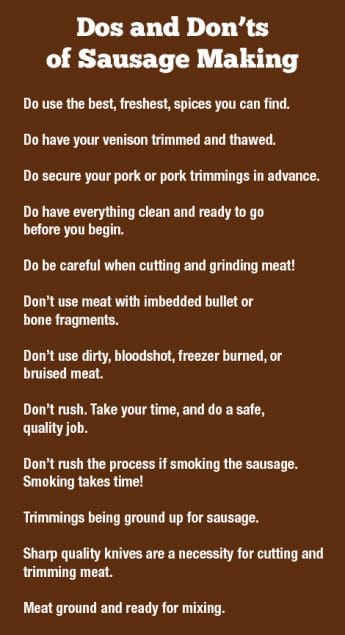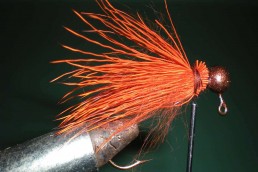Make Your own Venison Sausage at Home
SHARE THIS POST
It was a scene that would be taking place all over the U.S. after deer-hunting season. Three generations of my buddy’s family had gathered together to make venison sausage. Hunt stories were shared, next year’s plans were made, a few beers opened and jokes were told. As usual, someone will insist they had overpaid for the pork shoulders. However, more was accomplished than just turning venison trimmings into tasty sausage. A yearly tradition has been observed, and memories made.
Okay, so it was a good deer hunt, and you were able to harvest a deer or two. The better cuts will be turned into steaks, roasts, and chops. Meat from the front shoulders, flanks, and trimmed from various parts of the carcass can either be ground into burger, or turned into sausage. If you want to turn some of the trimmings into sausage, you have a couple of options. You can take the meat into a butcher shop and order the type and amount of sausage you want. Or, you can grind, mix and season your venison, and make the sausage at home.
Let the pros handle it?
Taking the meat to the local butcher has a few advantages. Before I took on home sausage making, I had lots of sausage made to order for me. You save the cost of buying the equipment, spices, casings, etc. and the time spent cutting, grinding, mixing, seasoning, and stuffing the finished product into casings. Add in the cost or wrapping paper or plastic freezer bags, as well. The downside of having the sausage made is the waiting time, cost, and that the venison used more than likely wasn’t your own.
Butcher shops making sausage right after gun season often combine meat to make the sausage in huge batches to fill the large orders from hunters. Obviously, making a 50- or 100-pound batch of venison sausage is more efficient than making a five or ten-pound batch with the small amount you brought in. If the trade-off of having your sausage made by a professional outweighs your urge to “do it yourself,” then by all means have it done for you.
Become a DIY pro
Making your own at home can be as simple or complex as you want. My son Adam and I started out with a hand-operated, cast-iron meat grinder that cost all of $1.00 at a rummage sale. We ground up some of the trimmings for burger, to use in venison chili, meatloaf, meatballs, etc. The rest went into our first attempt at breakfast sausage. We did it by combining bulk pork breakfast sausage 50-50 with ground venison. We added more of the spices used in breakfast sausage, made patties, and were pleasantly surprised by how well it turned out!
Later, we tried doing the same thing with bulk Italian sausage and adding spices and 50 percent ground venison. Once again, it turned out better than expected, and worked well on pizza, in meatballs, etc. If you don’t want to invest in all sorts of equipment, and are only making 10 to 15 pounds or so of sausage at home, this isn’t a bad way to go.
 Learning from those who know
Learning from those who know
When my coworker Tom invited me over to help make sausage at his home, I was impressed! Tom learned sausage making at home in Pennsylvania. He had several traditional recipes. He had a big electric grinder, sausage stuffer, huge mixing bowls, and even ground and blended his own spices. We trimmed fat and membranes from the meat and cut it into pieces for grinding. Pork shoulders were then boned out and also cut into chunks for grinding. His son T.J. was on hand to help. The day spent making sausage with these guys could hardly be called “work.” I donated some boneless pork trimmings, as well as some venison trimmings. We turned out some classic Italian link and bulk sausage, as well as some tasty breakfast sausage.
Are you enjoying this post?
You can be among the first to get the latest info on where to go, what to use and how to use it!
The next year, we secured a good Hungarian sausage recipe and expanded into making that variety. Between the Italian, Hungarian and some chorizo, we made almost 70 pounds of product.
Basic equipment
The higher the volume of meat ground, the larger the grinder you will need. Tom uses a high-volume electric model. Good quality, sharp knives are needed for trimming and cutting the meat into grinder-friendly chunks. You also need large, stainless-steel mixing bowls to hold the meat. After the meat is ground, mixed and seasoned, you will need a press called a sausage stuffer to force the seasoned meat into casings. Natural hog casings are the choice of home sausage makers. I suggest buying the best, freshest ones you can find. Casings that have sat for a while may have more holes in them due to the corrosive nature of the salt they are packed in. Rinse and flush the casings as directed on the package. Bulk sausage, for use in topping pizza or making meatballs, need not be stuffed into casings. Some folks use professional-grade butcher paper to wrap our sausage, but the finished product could also be placed in plastic freezer bags or vacuum packed.
Spices and recipes
Buy the best-quality, freshest spices that you can find. Avoid the spices for sale in the Supermarket or Dollar Store. You know, the same ones that were on the shelves last year, and that have color faded due to light exposure. We go to a locally famous spice store and get new spices for the year’s production run. The same goes for some of the boxed spice mixes sold in Sporting Goods stores. I can recall seeing some of the same boxes of bratwurst spice mix on the shelf at a local store for several years running. Check the expiration date before buying any boxed sausage-making spice mixes.
Italian, Hungarian, Bratwurst and Polish sausage take the larger-size casing. As mentioned before, natural hog casing is usually the best choice. Hot stick or beer stick sausage takes the smaller-diameter casing, usually sheep or collagen casing. Note that the smaller the diameter of the casing, the more finely ground the meat mixture needs to be. Stuffing the mix into small-diameter casings requires that it be in a slurry in order to flow into the casings. You will need to add water and/or some olive oil to make it a loose, gooey consistency.
Some of the best sausage recipes come from friends or relatives. There is also no shortage of recipes on the internet to try out. Try your favorite version, and adjust the taste according to your liking. Some folks favor a little more red pepper flakes or garlic powder than others, some less. We will take a basic recipe and fry up trial sausage patties and do taste testing. The taste testing can be half the fun!
In conclusion, if you want to try making a batch of venison sausage, I suggest giving it a try! Our sausage-making operation turned out 30 pounds of Italian, 25 pounds of Hungarian, and a 20-pound batch of chorizo. No one really kept track of what it cost. Just like the memories that were made, it was priceless!
MWO
SHARE THIS POST
Did you enjoy this post?
You can be among the first to get the latest info on where to go, what to use and how to use it!



